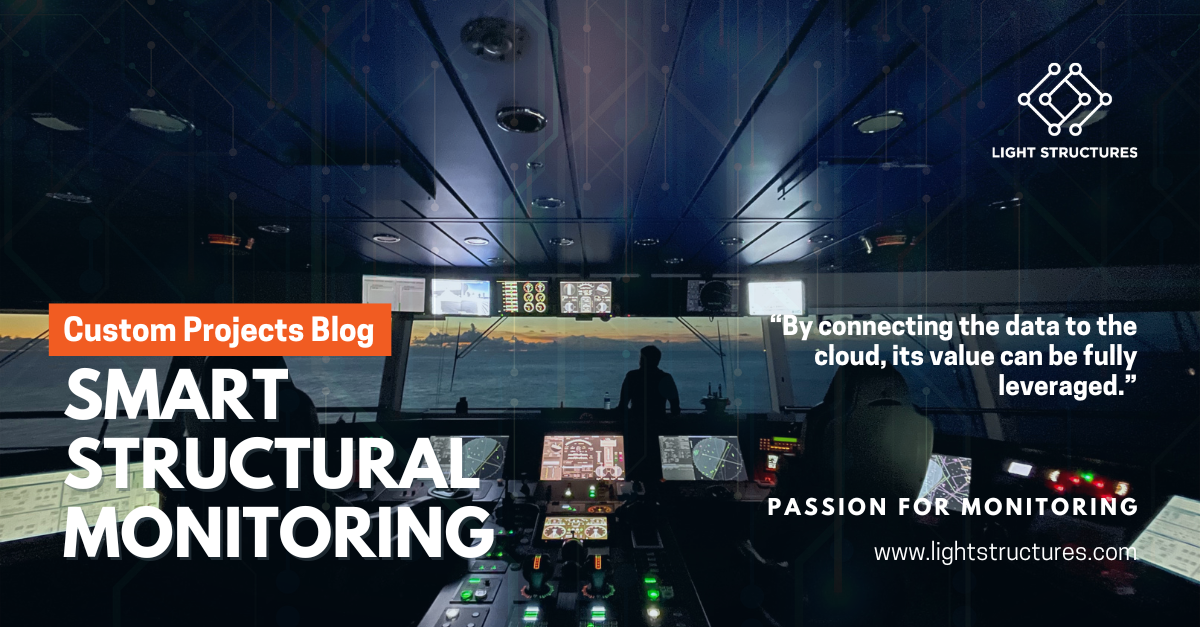Custom Projects: Smart Structural Health Monitoring

While maritime structural health monitoring helps to imrove operational safety, ensuring that ships, offshore platforms, and other assets remain structurally sound under the relentless forces of nature, it also offers value in other workstreams.
Today’s advanced maritime digitalization, including cloud-based platforms and digital twins are redefining the role of practically all vessel operations, including Structural Health Monitoring (SHM), which is set to become a key enabler of smarter, data-driven operations.
With smart SHM-certified systems like SENSFIB from Light Structures, asset owners can now move beyond conventional safety measures to optimise maintenance, extend asset life, and unlock operational efficiencies that were previously unattainable.
The shift to smart structural health monitoring
Standard monitoring systems provide critical real-time safety alerts onboard but are often standalone solutions, with limited integration into broader operational frameworks. The demand now in this connected age, is for integrating structural health data with digital platforms, enabling proactive, data-driven decision-making.
One of the key milestones in this evolution is the recent ABS SMART (SHM) certification for Light Structures’ SENSFIB structural health monitoring technology. This designation recognizes its ability to deliver high-fidelity structural data that can be seamlessly integrated into cloud-based analytics and digital twin environments. This advancement represents a major leap forward in how SHM is provided: It’s not just a safety mechanism, but as an essential component of a vessel’s digital infrastructure and lifecycle operations.
Unlocking the value of structural health data
At its core, smart SHM is about acquiring precise structural stress and fatigue data, distributing and storing it, analyzing it, and acting upon the insights it provides. Ideally this all takes place within a single platform, though there are many approaches to the data management and sharing aspects, usually decided by the asset owner.
By connecting the data to the cloud, its value can be fully leveraged – by our in-house experts or the customer’s own specialists. Regardless of who performs the analysis, operators can gain a holistic view of an asset’s condition, allowing for predictive maintenance and optimized lifecycle planning.
This capability aligns with the trend towards condition-based maintenance (CBM), where ship and platform repairs and inspections are scheduled based on dependable wear and tear data from the monitoring system, rather than fixed time intervals. This shift not only enhances safety but also reduces unnecessary maintenance costs and operational downtime.
Bridging physical and virtual worlds
One of the most transformative aspects of smart SHM is its ability to support digital twin technology. A digital twin is a virtual representation of a physical asset, continuously updated with real-time data to simulate structural performance under different operational scenarios. By integrating SENSFIB data into a digital twin, asset owners and engineers can visualize and
analyze stress patterns, predict fatigue hotspots, and simulate potential structural failures before they occur.
For instance, in offshore environments, FPSOs are subject to complex loading conditions that can accelerate fatigue in critical structural components. By leveraging SENSFIB data within a digital twin, operators can assess the long-term impact of these stresses and adjust operational strategies to mitigate risk. This level of insight is invaluable for ensuring asset integrity while maximizing operational uptime.
Smart SHM and classification cociety recognition
The growing adoption of smart SHM is further reinforced by recognition from leading classification societies such as ABS and DNV. With the ABS SMART (SHM) notation now available for vessels equipped with certified monitoring systems, shipowners can leverage structural health data not only for safety and maintenance but also as part of their compliance and class approval strategies.
Similarly, Light Structures’ collaboration with DNV underscores the industry’s shift towards integrating SHM data into digital twin solutions and condition-based inspection regimes. By aligning with classification society initiatives, asset owners can future-proof their fleets and offshore platforms, ensuring compliance with evolving digitalization standards while maximizing the benefits of continuous structural monitoring.
The future of smart SHM
The evolution of structural health monitoring from isolated safety systems to fully integrated digital solutions marks a paradigm shift in maritime operations. With SENSFIB’s SMART SHM capabilities, shipowners and offshore operators are no longer limited to reactive maintenance approaches. Instead, they can harness real-time data, predictive analytics, and digital twins to enhance asset performance, optimize maintenance strategies, and ensure long-term structural integrity.
As the maritime and offshore industries continue their digital transformation, the role of SHM will only expand. Those who embrace smart SHM today will be well-positioned to navigate the challenges of tomorrow, ensuring that their fleets and offshore assets remain not only safe but also operationally and financially optimized for years to come.
